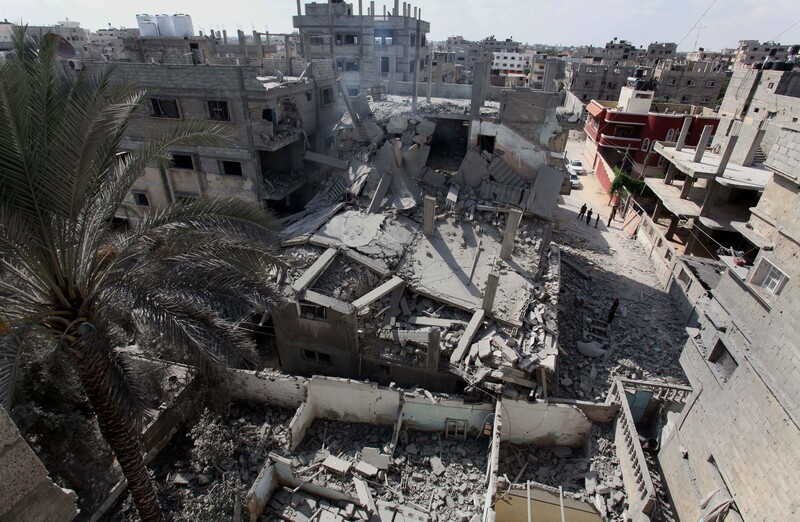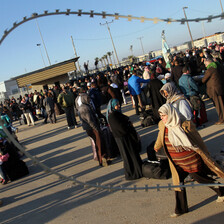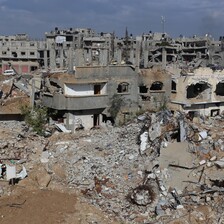The Electronic Intifada Gaza City 27 December 2014

A destroyed building after it was hit in an Israeli air strike in Rafah, southern Gaza Strip, 9 August.
APA imagesMuhammad al-Gharib says his life was turned upside down when his father and younger sister were killed in an airstrike during Israel’s 51-day offensive on the Gaza Strip this past summer.
Shortly after his father, Baha, 58, and his sister, Ola, 16, stepped out of their home in Rafah on 29 July, they were directly struck by an Israeli missile. “They were only about two hundred meters [218 yards] from the house when they died,” al-Gharib, a first-year university student, told The Electronic Intifada. “We ran outside and couldn’t believe what we saw. They were dead.”
“As the war got really bad during the last days of his life, it was like he knew something bad was going to happen,” al-Gharib said of his father. “He was laughing all the time and joking, but we had a bad feeling.”
Amid a summer of soaring tensions and frequent clashes in the occupied West Bank, including East Jerusalem, Israel launched its third major military operation in Gaza in the last six years.
Armed Palestinian factions fired rockets into southern and central Israel, while Israeli forces attacked the blockaded coastal enclave from air, land and sea.
Home to an estimated 1.8 million Palestinians, Gaza endured unprecedented destruction. Unlike during the 2012 attacks, the last full-scale assault on Gaza, Israel launched a ground invasion that devastated the Strip, particularly in areas bordering the south of present-day Israel.
Mass displacement
The United Nations monitoring group OCHA estimates that 2,257 Palestinians were killed as a result of the fighting, including 1,563 civilians. Sixty-six Israeli soldiers and seven civilians were also killed.
For Palestinians in Gaza, the war meant “a record number of civilian casualties, the devastation of civilian buildings and infrastructure, and large scale displacement,” according to OCHA. Some 100,000 persons are still displaced, living in schools, shelters or with host families.
On Saturday, 20 December, the day after a rocket fired by Palestinian fighters landed in an empty field in southern Israel, the Israeli military executed its first airstrike on Gaza since the 26 August truce.
Israeli forces have violated the ceasefire — including regularly firing live ammunition on Palestinians in Gaza — on a nearly daily basis since the truce.
Following the 20 December strike, Israeli Prime Minister Benjamin Netanyahu said Israel would not ignore “even one rocket launch” by Palestinian fighters.
The Israeli attack reportedly targeted a factory in Khan Younis, the second largest urban area in Gaza. Faced with the threat of new Israeli attacks, local Palestinians like Muhammad al-Gharib are still struggling to cope with the damage and losses of the last war.
His father Baha was one of at least sixteen media workers – fifteen Palestinians and one Italian national – who died during Israel’s deadly attacks, which it dubbed “Operation Protective Edge.”
A fluent speaker of Hebrew, Baha was the Israel affairs manager at Palestine TV. “His work was widely respected,” his son recalled. “People found his insight on Israel and its internal affairs very useful, and many [journalists] relied on his reporting because it was reliable.”
His sister Ola was one of at least 538 children killed during the attacks. Far surpassing the child fatality rate of Israel’s previous military offensives in Gaza, children were killed at a rate of twelve per day, according to the humanitarian organization Save the Children. Another 1,500 are estimated to have been made orphans during the summer assault.
“Appalling”
Brad Parker, attorney and international advocacy officer for Defence for Children International—Palestine, explained that Israel’s attacks in Gaza have consistently been “characterized by a complete disregard of international humanitarian law.”
Explaining that an estimated half of Gaza’s total population is under eighteen years old, Parker described the summer war’s impact on children as “appalling.” He added that it “should not shock anyone given the unprecedented scale of destruction, death and displacement kids in Gaza have been subjected to.”
“Children in Gaza witnessed the killing and maiming of their parents, siblings and other family members, and experienced the systematic destruction of their homes, schools and communities,” he told The Electronic Intifada.
Suffering continues
Although the latest war on Gaza ended with a ceasefire, Parker also warned that the suffering will continue, particularly for children, as long as Israel’s brutal seven-year blockade on Gaza remains intact.
“While widespread military operations have ended, the international community has failed to successfully pressure Israel to lift the blockade, which all but ensures the situation will continue to deteriorate for children in Gaza,” Parker said.
Nearly four months after the summer attacks ended, much of Gaza’s infrastructure still remains in shambles. In cities, towns and villages across the territory, entire neighborhoods are flattened. Due to strict Israeli restrictions and a lack of international action, reconstruction has hardly begun in most places.
At a donors conference after the war, $5.4 billion was pledged for Gaza’s reconstruction, mostly by Qatar, Saudi Arabia, the United States and the European Union. Only approximately half of that sum will go to Gaza’s reconstruction; the rest will instead be used to fill gaps in the West Bank-based Palestinian Authority’s budget.
Meanwhile, only two percent of the pledged reconstruction aid has been delivered thus far. “We have received funding and pledges of approximately $100 million for shelter and repair,” said Robert Turner, director of operations for UNRWA, the UN agency for Palestine refugees, Reuters news agency reported.
As a result of the ongoing Israeli blockade, which enjoys the support of the US-backed dictatorship in Egypt, construction supplies, such as steel and concrete, have trickled into the territory in quantities that don’t even come close to meeting Gaza’s immediate needs.
According to the humanitarian aid coordination body Shelter Palestine, the import building materials in November “constituted 13 percent of the October 2013 level, which represents less than 30 percent of the materials imported before the blockade” began back in 2007.
Muhammad al-Gharib says that the buildings and homes can eventually be rebuilt, but the lost lives can never be replaced.
“Every aspect of life is entirely different without my father and sister,” he remarked solemnly. “Every day has become a struggle. It’s so hard.”
Patrick O Strickland is an independent journalist and regular contributor to The Electronic Intifada. Find his reportage at www.postrickland.com. Follow him on Twitter: @P_Strickland_.





